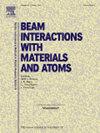Convolutional neural networks for reconstruction of neutron tomography from incomplete data
IF 1.4
3区 物理与天体物理
Q3 INSTRUMENTS & INSTRUMENTATION
Nuclear Instruments & Methods in Physics Research Section B-beam Interactions With Materials and Atoms
Pub Date : 2025-03-12
DOI:10.1016/j.nimb.2025.165682
引用次数: 0
Abstract
To reduce the number of image projections in neutron tomography experiments, tomography reconstruction algorithms are used from an incomplete and limited number of neutron projections. The possibilities of a reconstruction algorithm based on convolutional neural networks are presented. It was found that only 72 projections are required for trained convolutional neural network for a qualitative reconstruction comparable to that from a complete dataset. Variations in the quality of the tomography reconstruction due to changes in training data and the number of input projections are considered. Examples of using convolutional neural networks for neutron tomography reconstructions of real experimental data includes the results of studies on archaeological metal materials from the “Volna-1″ archaeological site.
基于不完整数据重建中子断层成像的卷积神经网络
为了减少中子层析成像实验中图像投影的数量,采用了基于不完整和有限数量中子投影的层析成像重建算法。提出了一种基于卷积神经网络的重构算法的可能性。研究发现,经过训练的卷积神经网络只需要72个投影就可以进行与完整数据集相当的定性重建。考虑了由于训练数据和输入投影数量的变化而导致的断层扫描重建质量的变化。使用卷积神经网络对真实实验数据进行中子层析成像重建的例子包括对“Volna-1″”考古遗址的考古金属材料的研究结果。
本文章由计算机程序翻译,如有差异,请以英文原文为准。
求助全文
约1分钟内获得全文
求助全文
来源期刊
CiteScore
2.80
自引率
7.70%
发文量
231
审稿时长
1.9 months
期刊介绍:
Section B of Nuclear Instruments and Methods in Physics Research covers all aspects of the interaction of energetic beams with atoms, molecules and aggregate forms of matter. This includes ion beam analysis and ion beam modification of materials as well as basic data of importance for these studies. Topics of general interest include: atomic collisions in solids, particle channelling, all aspects of collision cascades, the modification of materials by energetic beams, ion implantation, irradiation - induced changes in materials, the physics and chemistry of beam interactions and the analysis of materials by all forms of energetic radiation. Modification by ion, laser and electron beams for the study of electronic materials, metals, ceramics, insulators, polymers and other important and new materials systems are included. Related studies, such as the application of ion beam analysis to biological, archaeological and geological samples as well as applications to solve problems in planetary science are also welcome. Energetic beams of interest include atomic and molecular ions, neutrons, positrons and muons, plasmas directed at surfaces, electron and photon beams, including laser treated surfaces and studies of solids by photon radiation from rotating anodes, synchrotrons, etc. In addition, the interaction between various forms of radiation and radiation-induced deposition processes are relevant.

 求助内容:
求助内容: 应助结果提醒方式:
应助结果提醒方式:


